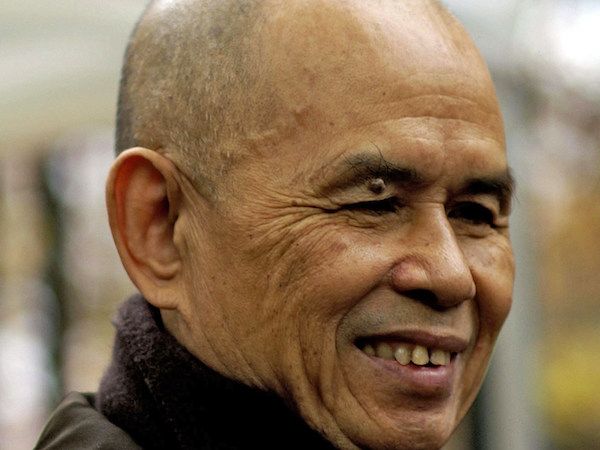Thich Nhat Hanh, one of the world's most popular and influential Vietnamese Buddhist monks, passed away on January 22 at the age of 95 in the temple of Tu Hieu, Vietnam, where he had begun his studies as a teenager and to which he had returned a few years ago. Exiled from his country during the war because of his pacifist commitment, Thich Nhat Hanh lived between Europe and the United States for almost forty years. With his activism, his social commitment and his ability to communicate and translate the complexity of Buddhist thought into practices and gestures for the community, Thich Nhat Hahn marked the history of Buddhism and Vietnam in the 21st century. Thich Nhat Hahn rejected the image of the hermit monk withdrawn from public life, spendig almost his entire life travelling around the world, being socially committed to helping others and spreading Buddhist practice. During his lifetime he also wrote 130 books.
Professor Richard Quang-Anh Tran, who teaches Vietnamese language and literature at Ca' Foscari, helps us remember Thich Nhat Hanh’s life and the global influence of his thoughts and actions.
Thich Nhat Hanh's life was centered on Buddhist practice and social activism. How did he balance these two aspects of his life?
The Buddhism of Thich Nhat Hanh's was unique because his engagement in public life to teach others was at the heart of his Buddhist practice. In particular, he was strongly engaged in opposing the Vietnam War and started a nonviolent resistance movement called the "Small Peace Corps", made up of monks but also of lay people who were committed to rebuilding schools and hospitals after the bombings. In those years, in his 1967 book Vietnam: Lotus in a Sea of Fire, Thich Nhat Hanh coined the term "engaged Buddhism", inspired by Mahāyāna, the most widespread Buddhist current today, which highlights the monk’s role in teaching and their social commitment.
One of the ideas of engaged Buddhism was to urge monks, nuns, and lay followers not to be bystanders, living a hermetic life isolated from society, but to engage actively in relieving the suffering of others. The basis for this idea comes from the notion of "interbeing", according to which each of us is interconnected to the others in a complex web of which we may not be fully aware. This notion may seem abstract at first, but it is palpable today when we think about issues like climate change: the actions of people in one corner of the globe create ripple effects — be they large or small — in another corner of the planet. In light of this, one understands the ideals of pacifism that led Thich Nhat Hanh and his followers to support humanitarian relief efforts to rebuild schools and villages during war. This was a thought that came in response to the suffering of war, but was also central to his life in later years.
The concept of engaged Buddhism also led Thich Nhat Hanh to travel to the United States in the 1960s where he taught at Princeton and at Columbia University while continuing to advocate for an end to the conflict in Vietnam. In the USA, he met Martin Luther King, who in 1967 proposed him as a candidate for the Nobel Peace Prize. In the following years, in the south of France he founded Plum Village, a large Buddhist monastery, which hosts over two hundred monks and nuns and ten thousand visitors a year, of different ages, backgrounds and faiths, who go there to learn how to meditate. The idea behind these monasteries is that achieving inner serenity can have positive effects on others and help channel positive energy for altruistic purposes. The usability of these meditative practices is very attractive and allowed Thich Nhat Hanh to get in touch with anyone: lay people, people belonging to other religious faiths, academics. Thich Nhat Hanh also managed to establish a dialogue with large companies, such as Microsoft and Google.
In your opinion, why was he so influential on a global scale? Can Buddhist practice still be considered “authentic” when it is applied to contexts very different from its original ones?
We can say that the idea of "engaged Buddhism" is the core of Thich Nhat Hanh’s thought and the key to understanding the diffusion of his ideas and practices in Western countries. The reason why Thich Nhat Hanh had such a large following is to be found precisely in his ability to translate the philosophical concepts at the heart of Buddhism in a comprehensible and engaging way for a wide audience, without losing sight of its fundamental aspects, but making them an inspiration for social commitment and mutual aid. This is the secret of the planetary success of engaged Buddhism — proposing a life practice that can be applied immediately, aimed at helping others and that can be adapted to different realities. After all, Buddhist thought is centered on a cosmology based on the interconnectedness of the parts. In a simple image: we can see reality as a flame that burns and remains the same even though it never really is the same. In this sense, asking what is "authentic" about a religious movement is complex. Thich Nhat Hanh managed to preserve the fundamental concepts of Mahāyāna Buddhism, translating them and making them accessible.
In a way, the strength of our Department of Asian and North African Studies lies precisely in the effort to translate concepts. Many of the central themes of Buddhist thought and history can be approached by students, for example, in the courses of the curriculum that focuses on Southeast Asia: it can be a way to understand the philosophical, religious, historical, and cultural influences of Buddhism in Vietnam and Southeast Asia, as well as their spread around the world, including in Europe.











